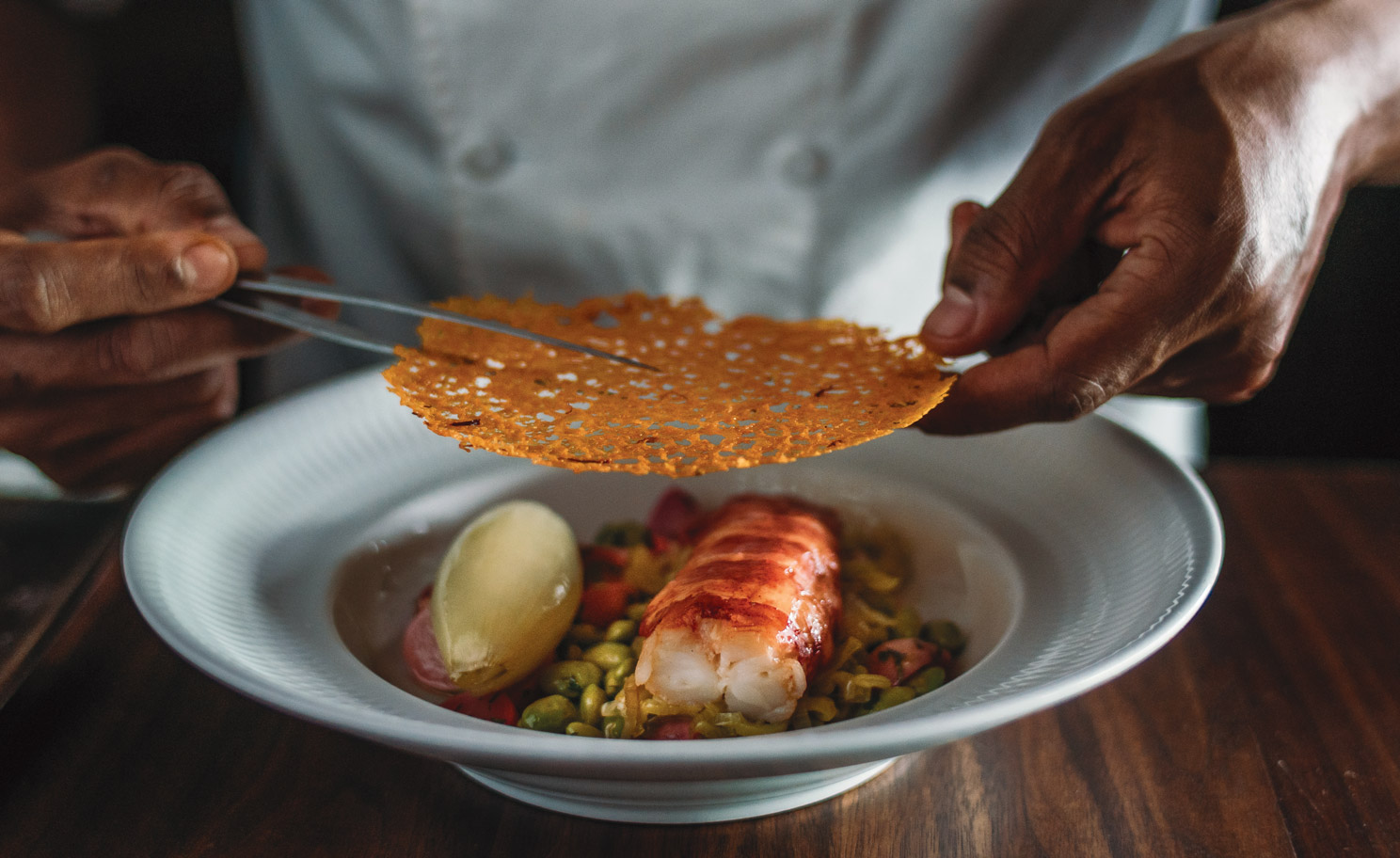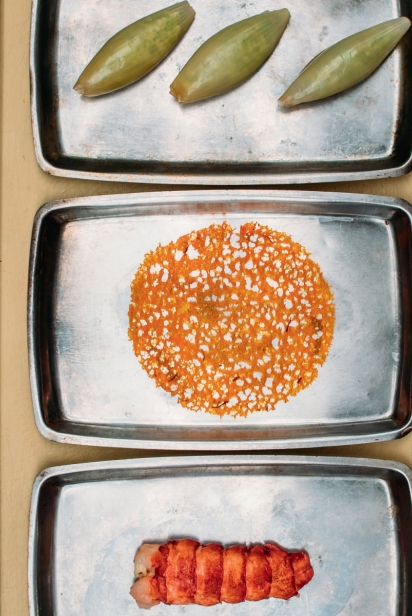Chef Sean Streete
GRAVITY TAVERN, MILL VALLEY
Sean Streete, executive chef at Gravity Tavern in the hamlet of Mill Valley, makes very beautiful food. Food that is art, food with wit, food that evokes emotions before you even take a bite.
After interviewing Sean, this multi-layered culinary expression makes sense. His story zigs and zags, and his experiences are vast. He finds a way to bring to it all together on the plate, even a to-go box these days.
Sean’s father, a Jamaican agronomist, and his mother met on her home of Trinidad, while he was on the island studying sugar cane. He brought her, as she would joke, “away from her rich and lush home to poor Jamaica.” Political violence in the country eventually led Sean’s parents to relocate their family to California, initially staying with his mother’s brother who was a veterinarian here. Much of the family soon followed.
“My parents were always moving towns, and the family would wonder if they were trying to get away from them,” Sean laughed. From the East Bay, to the South Bay, to Gilroy and finally to Pleasanton, he was always surrounded by aunts, uncles, cousins and grandparents. And always in the kitchen.
There was Trinidadian curry, brightly colored and spiced with turmeric, and Jamaican curry, deeper-toned and heavy on allspice. And always a stash of “good curry” for special meals. Cooking with his family meant the rivalry of two cultures, and the creation of a new culture that embodied both. “You never say whose curry you like best. That would start a war,” he said in all seriousness.
In high school, Sean and a friend started a jerky business they called Itcanian Productions (the friend was Italian). When they realized their main audience of reggae concert-goers wanted vegetarian options, they pivoted to fruit and vegetable jerky. After graduation, Sean studied business administration at a junior college, got into real estate and became a landlord. He was married and living well when the market bottomed out.
“I was just chasing the money, and I wanted to do what I love.” His marriage ended and he packed up a few belongings and headed to Miami, where his parents had once again (unsuccessfully) attempted to strike out on their own.
While attending Le Cordon Bleu College of Culinary Arts in Miami, Sean took an externship at Sandals Whitehouse in Jamaica, returning to his place of origin and where he had spent many summers in his childhood. As an outsider and still a culinary student (“I had a toque and everything,” he recalled), he did very little cooking. “It was like they admired my education, but also didn’t really trust me to work.”
He thought he would stay in Jamaica and continue the resort life, but when he got a call that his father had stage 4 cancer he headed back to the States.
Sean got a job as a line cook at 95 Cordova in St. Augustine, Florida, where his parents were living. It was the first job after culinary school where he was actually cooking, and the head line cook let him know that his skills were not up to par. Sean set to work to become the fastest cook in the kitchen.
He returned to California to stage at Thomas Keller’s Bouchon in Yountville. “I was somewhere between star struck and having my butt handed to me the whole time,” he recalled. Chef Philip Tessier, then at Bouchon and now executive chef at PRESS in St. Helena, offered Sean a job, but that meant leaving his sick father for more than a short-term stage. His extended family stepped up, and everyone insisted Sean make the move. His mentor at 95 Cordova knew he needed to go, “Go out there and kill it,” he told Sean.
“If I was the fastest at 95 Cordova, I was standing still at Bouchon” Sean recalled. There, Sean learned the efficiencies of movement and intention that are a trademark of Keller kitchens. He learned that showing up less than one-and-a-half hours early for your shift was the same as being late. He learned sometimes it was just easier to sleep in your car in the parking lot than drive home. He learned that if you planned right, you only needed to make one trip to the walk-in.
Once you have learned these lessons, you may enter the rewarding, and grueling, culture of star kitchens. The lessons become your resume. From Bouchon, Sean went to downtown Napa’s Morimoto, and then to Auberge du Soleil. At Auberge, they assumed Sean was a fish expert from his time with Chef Morimoto, so he “faked it until he made it,” figuring out how to fabricate whole fish on the spot. Next up was Meadowwood, cooking under Chef Christopher Kostow.
After these star-studded sous chef positions, Sean knew he was ready to take on more of a leadership role and accepted the executive sous chef position at the Carneros Resort and Spa.
Last spring, just as the Covid-19 shutdown began, he finally took on the mantle of full leadership, as executive chef at Gravity Tavern. Poised to show the full breadth of his expertise and experience gleaned in Michelin-three-starred kitchens, Sean seems to take the required “pandemic pivots” in stride. In the manner of a true leader, he is now practicing restaurant survivalism: cooking what works.
If you scan @mr.streete on Instagram, you will see dishes that look like sculpture, that have an ephemeral temporality. They are not the dishes of to-go boxes, not dishes that make it home balanced on laps (although goat curry could work—just a suggestion, Chef…). In this extraordinary moment in all of our stories, Chef Sean Streete is showing the skill and determination that place him squarely in the ranks of great chefs.
Edible Marin & Wine Country: What was the first meal you made that you were proud of ?
Chef Sean Streete: When I was about 10 years old, I prepared glass noodles with crab meat and a dessert waffle for Mother’s Day for my mother, a registered nurse who worked late hours. I left the dish in the refrigerator with a note attached, so she would find it when she woke up. My mom still speaks about this meal.
EMWC: What was your favorite food as a kid?
One of my favorite things to come home to was the aroma of curry chicken. You could smell it before you entered our home. The dish represented warmth and a home filled with culture and love. I tend to criticize anyone who thinks they can properly execute this dish.
EMWC: What food do you wish you loved?
Sweets. I prefer more acidic profiles.
EMWC: What food do you love unreasonably much?
Curried goat! My dad and I still debate my memory of having goat curry with tripe as a child. He tells me that I must have been daydreaming, but I beg to differ … respectfully.
EMWC: What is the most difficult cooking technique to do well?
Baking. I don’t have the patience for all of the measuring and weighing.
EMWC: What are you exploring in your kitchen now?
I’m more concerned these days about showing the cooks in my kitchen all of my techniques.
EMWC: What nonculinary influence inspires you?
Everything that I see and feel inspires my creations. Sometime over the past two years I feel that I’ve changed my direction in the culinary world and now consider myself an artist, just as much as being a chef.
EMWC: What is your idea of a very healthy meal?
Seasoned grilled chicken, accompanied by lightly sauteed spring vegetables. In the spring, vegetables don’t have tough skin and contain a lot of natural sweetness, so they don’t need to be manipulated much
EMWC: What is your favorite ingredient?
Golden balsamic vinegar. I was taught the value of applying and/or finishing foods with vinegars or a squeeze of citrus. This can easily be the difference between someone remembering what you fed them, or not.
EMWC: What is your favorite hangover meal?
Ramen!!!
EMWC: What restaurant in the world are you most dying to try?
Chef Grant Achatz’s Alinea in Chicago
EMWC: What kitchen utensil is most indispensable to you?
Precision tweezers!
EMWC: Whom do you most like to cook for?
I most enjoy cooking for the guest who walks in and asks for an “off the menu’’ vegetarian option. It forces you out of your comfort zone to create something other guests swoon over.
EMWC: If you could do one other job, what would it be?
Spear fisherman
EMWC: What is your favorite midnight snack?
Pan-roasted cashews, but only if there isn’t any leftover Panda Express in the refrigerator.
EMWC: What most satisfies your sweet tooth?
I have an unhealthy obsession with orange Tic-Tacs. I consume four to six packs a day.
EMWC: What would you eat at your last meal, if you could plan such a thing?
Curry goat, rice and peas, and fried plantain.
EMWC: What’s your favorite place to go for (and what is your favorite thing to order) for
…a splurge meal?
Morimoto’s in Napa. The culture, in addition to the food, always leads to a great experience.
… breakfast?
Denny’s vegetarian omelet, of course!
… pastry?
Not a fan of eating pastry, but I do appreciate the artistry as I try and mimic a lot of my food presentations with ideas that I find in the patisserie world. Bouchon Bakery in Yountville never disappoints.
… a late-night/after-work meal?
Isn’t Panda Express the universal after-work meal for chefs? I’m happy as long as it contains chow mein and fried rice.
…a cup of coffee?
My current obsession is hazelnut coffee from 7-Eleven. I usually get two cups, so that I can heat up the additional cup in the microwave the following day. Don’t judge me.
… a greasy spoon meal?
Any after-hours Korean restaurant in SF will do the job. I love bibimbap or anything with kimchi in it: yukgaejang (beef stew), budae jjigae (kimchi-based stew), haemul pajeon (fried seafood pancakes); and they must be accompanied by soju.
… place to shop for groceries?
Outside of the Marin Farmers’ Market, I feel out of place in a grocery store. Having worked in the kitchen for the better part of the last 10 years, it’s very rare that you would find me in a grocery store.
… kitchen equipment?
Shackford’s in Napa. Otherwise, I send a request to my TriMark representative and it shows up at the door a few days later.
… ice cream flavor?
Breyer’s Natural Vanilla ice cream, partially melted, so that it might as well be creme anglaise. But I don’t like milk, so timing is of the essence.
… chocolate?
White chocolate, only.
And lastly but not leastly … what is your favorite local wine or beer for the season?
I consider myself an extreme consumer of sparkling wine. I’m a big fan, and whenever the opportunity arises I frequent the local houses like Schramsberg, Domaine Carneros and Gloria Ferrer.







